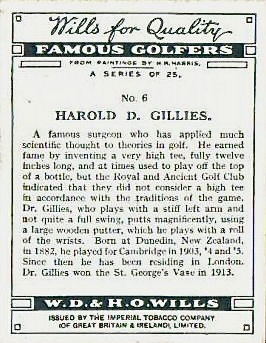Golf
Gillies became nationally famous as much for his influence on the game of golf as for his pioneering surgery.
He became a golf obsessive whilst at Cambridge University. Almost by accident he achieved his half blue, after consistently beating one of the team and passing three trials prior to one weekend match in 1903, held at Sandwich in Kent.
At Barts he became known principally for his talent at the game, once winni ng a bet to put a ball through the
ng a bet to put a ball through the
rugby pitch summerhouse with a 90-yard chip. He used the bathroom of his first lodgings in London to practice relentlessly, finding the one spot in the room where his swing would not damage anything. Recently reaching the fifth round of the English amateur championship, he even acquired his first job, working for the renowned ENT surgeon Sir Milsom Rees, by demonstrating his swing and talking golf at the interview.
His training in anatomy is said to have drawn him to the conclusion that “keeping the eye on the ball” was more about allowing the organs of balance to maintain maximum steadiness, than a visual imperative. Gillies led the French Open at Chantilly in 1913, ahead of the reigning Open champion, J.H. Taylor, and numerous French professionals. As an amateur himself, this was unknown. That same year he also won the most prestigious amateur trophy in golf, the Royal Saint George’s Champion Grand Challenge Cup at Sandwich. In the 1920s, Gillies, with a handicap of +2, went on to represent England three times against Scotland.
Later in his career Gillies became a regular at the Sidcup golf course, partly as a means of distracting from the horrors on the wards. It is said that he only ever lost one game, on a day he was brooding about losing a patient.
Perhaps mirroring his surgery, and forever affected by a childhood injury giving him a stiff elbow, Gillies developed an unusual approach to golf. One morning at Woking, there had been a hard frost preventing him using a conventional tee. He placed the ball on top of a beer bottle, thereby inventing the “High Tee” for which he became known in the game. It even prompted a cartoon in the “Daily Mail”. He substituted bottles for an eight-inch rubber tube and had clubs made to match, with heads attached at a more obtuse angle, and measuring two and a half inches in height. The tee, clubs and Gillies flat swing influenced a few professionals to take up the technique and provided him with some record-breaking drives. Nevertheless, it did not go down well everywhere, The Scotsman newspaper calling Gillies’ tee “not right” and the St Andrew’s Amateur Championship Committee censuring him in 1924.
Gillies’ golfing exploits are many, and the stories legendary. He once lined five balls up on tees, one in front of the other, smashing all of them down the centre of the fairway in one mighty blow. The practical joker often emerged too, once replacing a partner’s ball with one carefully made from plaster of Paris, which disintegrated in a cloud of dust when hit. He never did quite take the game, nor its authorities entirely seriously, a trait which characterised his whole approach to life.